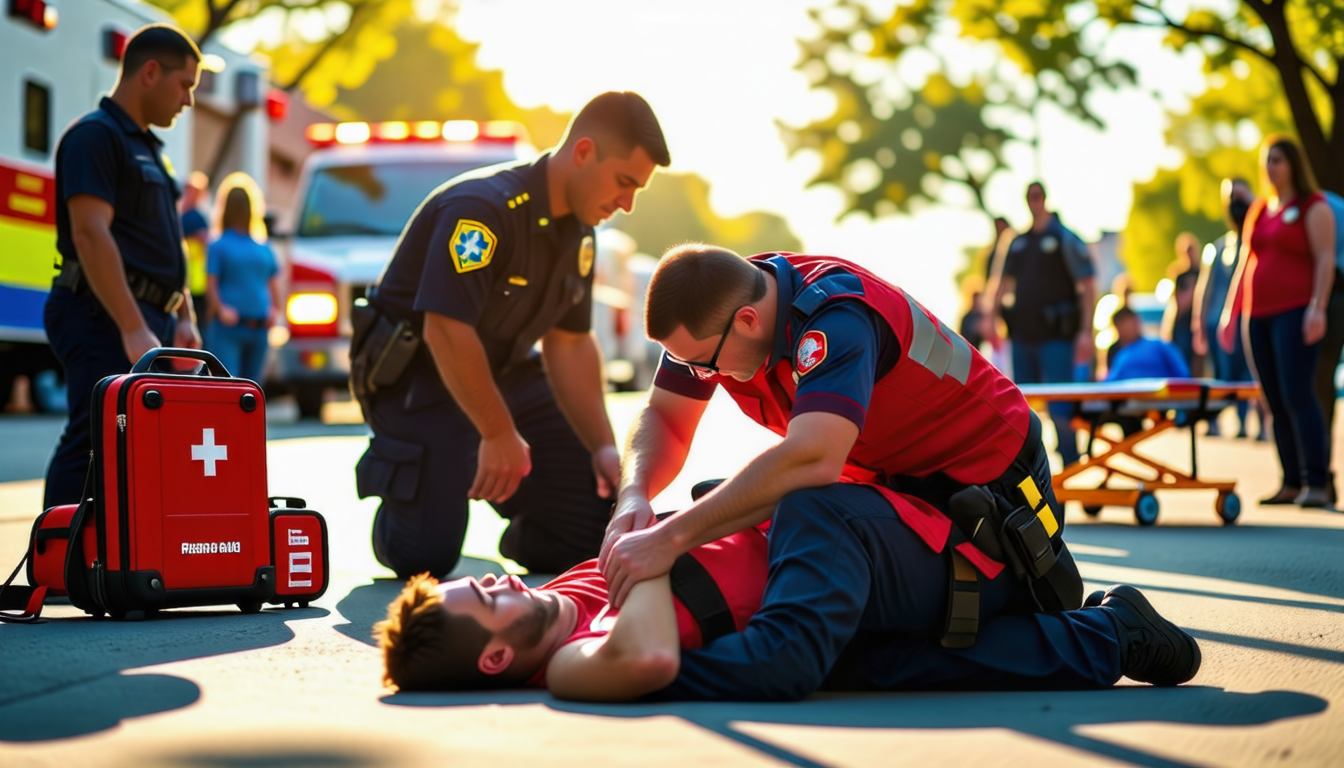|
In Brief
|
In the face of a medical emergency, every second counts. The ability to provide effective first aid not only demonstrates a commitment to helping others but can also mean the difference between life and death. Understanding the fundamental response techniques for various health crises is essential for anyone, regardless of their background or training. Familiarity with the DRSABCD action plan empowers individuals to assess situations swiftly, ensure their own safety, and administer the necessary care to those in need. By mastering these critical skills, you can transform from a passive observer to an active lifesaver, capable of navigating through high-stakes scenarios with confidence and composure. Embrace the knowledge that equips you to respond with efficacy in emergencies.

Understanding First Aid Response Techniques
In emergency situations, knowing the correct first aid response techniques can make a significant difference. Whether encountering a fainting spell, a cardiac arrest, or minor injuries like cuts and sprains, understanding basic first aid principles can save lives. The foundation of effective first aid is rooted in a systematic approach that prioritizes safety, assessment, and immediate care.
Basics of First Aid: The DRSABCD Action Plan
Implementing the DRSABCD action plan is crucial in any emergency. This acronym represents the key steps crucial for responding to medical emergencies:
D – Danger: First, ensure the safety of both the responder and the casualty. Assess the environment for potential hazards.
R – Response: Check the casualty’s level of consciousness by gently shaking their shoulders and asking if they are okay.
S – Send for help: If the person is unresponsive or requires assistance, call emergency services immediately.
A – Airway: If unresponsive, tilt the head back slightly to open the airway, ensuring there are no obstructions.
B – Breathing: Look, listen, and feel for any signs of breathing. If the person isn’t breathing, prepare to administer CPR.
C – CPR: Administer chest compressions and rescue breaths as needed.
D – Defibrillation: Use an Automated External Defibrillator (AED) as soon as one is available, following the instructions provided.
Responding to Unconsciousness
Unconsciousness requires immediate intervention. Begin with checking the person’s airway; this can be achieved by carefully tilting their head back. Once the airway is clear, assess for breathing. If the individual exhibits no signs of breathing, activate the emergency response and start CPR. Each cycle should consist of 30 compressions and two rescue breaths, continuing until professional help arrives or the individual begins to show signs of life.
In Cases of Shock
Shock is a life-threatening condition that occurs when the body does not get enough blood flow. Common signs include pale skin, rapid pulse, and shallow breathing. If you suspect shock, it is vital to call for emergency medical assistance.
While waiting, help the person lie down in a comfortable position and elevate their legs if there are no injuries to the legs or spine. Keep them warm with a blanket to prevent hypothermia, and monitor their breathing and pulse continuously.
Responding to Bleeding Emergencies
When a person experiences bleeding, quick actions can aid in the control of blood loss. Start by ensuring the scene is safe, and then assess the situation. If the wound is severe, take measures to prevent infection and further bleeding.
How to Control Severe Bleeding
To manage a bleeding wound, apply direct pressure with a clean cloth or your hand directly onto the wound. If blood soaks through the cloth, do not remove it; instead, add additional layers while maintaining pressure. If the bleeding does not stop within 10 minutes, seek emergency services.
Addressing Cuts and Scrapes
Minor cuts and scrapes can occur frequently. Although they might not seem critical, proper treatment is essential to avoid infection. First, wash your hands to maintain hygiene.
Clean the wound using soap and water, gently removing any dirt or debris. Following this, apply an antiseptic and cover the cut or scrape with a sterile bandage to protect it from further injury.
Understanding Sprains and Strains
Sprains and strains are common injuries that can occur during physical activity. For sprains, where ligaments are stretched or torn, apply the RICE method: Rest, Ice, Compression, and Elevation. Start by resting the affected area and applying ice packs to reduce swelling. Wrap the area with a compression bandage and elevate the limb to minimize swelling.
Cardiac Emergencies and CPR
Cardiac emergencies, such as heart attacks, require immediate action. Recognizing the signs of a heart attack, which may include chest pain, discomfort in other areas (like arms, back, neck, or jaw), and shortness of breath, can prompt timely intervention.
If you determine someone is experiencing a heart attack, do not hesitate to call emergency services. If the person becomes unresponsive, perform CPR swiftly. Follow the DRSABCD action plan already mentioned for appropriate management.
Using an AED
When available, an Automated External Defibrillator (AED) is a valuable resource. Follow the audible instructions provided by the AED to administer shocks if needed. Using one significantly increases the chance of survival for someone experiencing a cardiac arrest.
Handling Choking Situations
Choking can occur when a person’s airway becomes blocked by food or another object. Recognizing choking signs including inability to speak, difficulty breathing, and coughing can prompt quick action. If the person can cough but doesn’t seem to clear the obstruction, encourage them to continue coughing. If they cannot breathe or speak, proceed with back blows followed by abdominal thrusts (Heimlich maneuver).
Different Techniques for Various Ages
It’s important to note that techniques change slightly depending on the age of the individual in distress. For infants, alternate between 5 back slaps and 5 chest thrusts, always ensuring they are resting on your forearm. For older children and adults, the Heimlich maneuver — abdominal thrusts — is appropriate.
First Aid for Burns
Burns can result from heat, chemicals, or electrical sources. The initial step in treating any burn is to remove the source of the burn if possible. For thermal burns, cool the burn under running cool water for at least 10 minutes to reduce damage and pain.
After cooling, cover the burn with a sterile, non-adhesive dressing. Avoid using ice directly on the burn and never apply ointments or creams, as they can trap heat and worsen the injury.
Identifying and Responding to Heat Exhaustion
Heat exhaustion can occur in conjunction with high temperatures and strenuous activity. Symptoms include heavy sweating, weakness, dizziness, and nausea. To address heat exhaustion, it is imperative to move the person to a cooler place, provide cool water, and apply wet cloths to their skin.
Recognizing the Signs of an Asthma Attack
Asthma attacks can sometimes escalate into emergencies. An individual experiencing an asthma attack may exhibit wheezing, a tight chest, and difficulty breathing. If the person has a prescribed inhaler, assist them in using it as needed. If symptoms persist or worsen, seek medical help immediately.
Understanding the Importance of First Aid Training
While knowing these first aid techniques is invaluable, proper training is equally essential. Participating in certified first aid and CPR courses enables individuals to effectively respond in emergency situations, thus potentially saving lives. Organizations like the American Red Cross provide comprehensive training programs, equipping people with the necessary skills.
For those aspiring to enter the medical field, understanding these fundamental first aid techniques can serve as a foundation for future learning and practice. Many resources are available to support this journey; for example, medical school application tips for aspiring doctors can help those interested in pursuing a career in healthcare.

When faced with emergency situations, knowing first aid response techniques can be a life-saving skill. According to the American Red Cross, about 70% of adults feel helpless to act during a medical emergency. However, understanding the fundamental steps of first aid can significantly empower individuals.
One of the essential strategies is the DRSABCD Action Plan. This approach starts with ensuring the safety of both the responder and the victim, followed by assessing the victim’s level of consciousness, breathing, and circulation. It encourages check-ups for any bleeding, and if necessary, initiating CPR. Statistics reveal that immediate CPR can double or even triple a person’s chance of survival after cardiac arrest, as noted by the American Heart Association.
Moreover, it is crucial to call emergency services promptly. By doing so, individuals can ensure that professionals are on their way while providing necessary care. Effective communication and taking quick measures can greatly influence the outcome of various medical emergencies.
In addition, accessing resources like emergency room procedures can provide valuable context to the follow-up care needed after performing first aid.

In any emergency, knowing how to respond can mean the difference between life and death. The fundamental first aid techniques are crucial for effective intervention. First, assess the scene to ensure safety for both yourself and the victim. Use the DRSABCD framework to guide your actions: check for Airway, ensure Breathing, and provide CPR if necessary. Always remember the three C’s: check, call, and care. Whether addressing critical issues like unconsciousness or minor injuries like cuts and scrapes, applying the correct procedures promptly can significantly enhance the chances of a positive outcome. Continuous learning and practice of these techniques are vital to being prepared for any unforeseen circumstances.
FAQ
What is the first step in a first aid response during emergencies?
R: The first step is to ensure safety for yourself and the victim. Assess the situation to determine if it is safe to approach and provide assistance.
What does the acronym DRSABCD stand for in first aid?
R: DRSABCD stands for Danger, Response, Send for help, Airway, Breathing, CPR, and Defibrillator, outlining the essential steps to take in a medical emergency.
How should I check for consciousness in an unresponsive person?
R: Gently tap the person and ask if they can hear you or respond. If there is no response, proceed to open their airway and check for breathing.
What should I do if someone is bleeding heavily?
R: Cover the wound with a clean cloth and apply direct pressure to control the bleeding. If possible, elevate the injured limb above the level of the heart.
When should I call emergency services during a first aid situation?
R: You should call emergency services if the situation is beyond your control, if the person is unresponsive, unable to breathe, or if there are serious injuries that require professional medical assistance.

